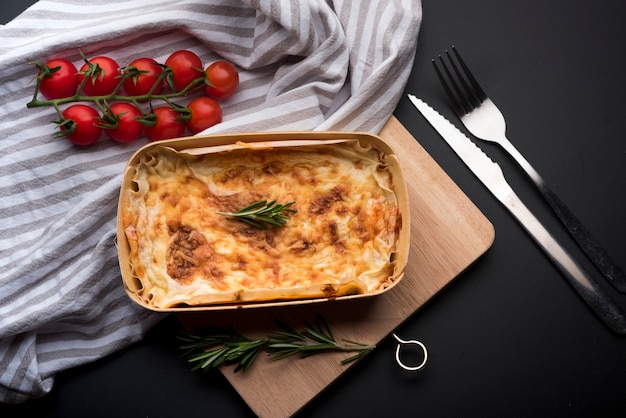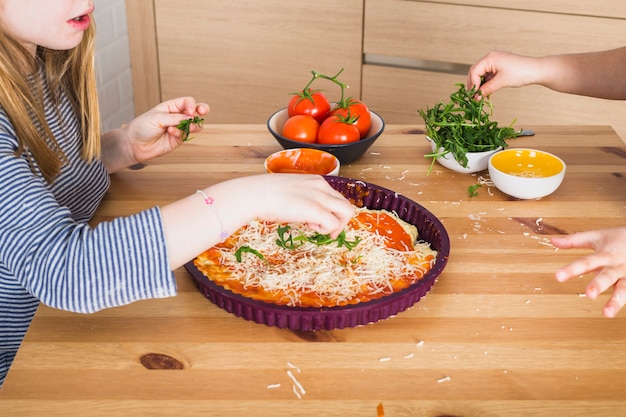Ah, lasagna. The quintessential comfort food, a symphony of flavours and textures that makes everyone happy. But even for seasoned cooks like myself, there's always a touch of uncertainty when it comes to baking time. How long do you bake it for that golden-brown, bubbling perfection? It's a question I get asked all the time, and believe me, I've been there too. But over the years, I've developed a system, a lasagna-baking intuition, if you will. It's a blend of tried-and-true techniques, a dash of gut feeling, and a whole lot of delicious trial and error. So buckle up, because I'm going to share all my secrets and tips for achieving lasagna perfection, from the first layer of sauce to the last golden crust.
Part 1: Laying the Foundation - Understanding the Baking Process

Temperature Tango: The Art of Oven Control
Think of baking lasagna like a delicate dance between temperature and time. You need the right heat to create that beautiful golden-brown crust, but you don't want to rush the process and burn the cheese before the pasta is cooked through. The perfect temperature is the sweet spot that allows for even cooking and a delicious melt. Too low, and you'll be waiting forever, too high, and you'll be facing a burnt offering. It's a balancing act, and it takes practice to get it right.
The Factors that Determine Baking Time
Now, let's talk about the elephant in the room – the "how long" question. There's no single answer, my friend, because it depends on a whole host of factors. You've got to consider the size and shape of your dish, the type of oven you're using, and even the ingredients themselves. Here's a deeper look at the variables that can make or break your lasagna:
- The Dish's Dimensions: A shallow dish will heat up faster than a deep one, leading to a shorter baking time. Think of it like a swimming pool – the shallower it is, the quicker the water warms up.
- Oven Variations: Every oven has its own personality. Some run hotter than others, even if you set the dial to the same temperature. It's like having a chatty friend who always turns up the volume. You might need to adjust baking time accordingly.
- Layers Upon Layers: More layers mean more pasta and filling, and that translates to more time to cook everything through. Think of it like building a tower – the higher it is, the longer it takes to build it.
- Pasta Power: fresh pasta sheets are thicker and tend to need longer baking times than pre-cooked noodles. Fresh pasta has a more robust flavour, but it's also a bit more demanding.
- Personal Preference: Some folks love a soft, melty cheese, while others prefer a slightly crispy top. This is where your personal taste comes into play. If you like your cheese on the crispier side, you might bake it for a few minutes longer.
Part 2: Setting the Stage - Preparing Your Lasagna

Choosing the Perfect Stage: The Baking Dish
For me, a 9x13 inch baking dish is my go-to. It's the perfect size for a lasagna that's big enough to feed a crowd but not too overwhelming. But feel free to experiment with different sizes. Just remember to adjust your baking time based on the dish's capacity. You wouldn't try to fit a whole orchestra into a tiny closet, would you?
The Layered Symphony: Building the perfect lasagna
This is where the magic truly begins, the art of layering the lasagna. I like to think of it as building a culinary tower of flavour. The classic lasagna has three essential layers:
- The Foundation: The Sauce: Start with a thin layer of your favourite tomato sauce. This sets the stage for the entire flavour profile. It's like laying the groundwork for a beautiful house – you want a solid foundation to support the rest of the structure.
- The Pasta: Time to choose your pasta. Dried sheets are a classic choice, but fresh pasta adds a rich, intense flavour. Whichever you choose, make sure it's cooked al dente, meaning it's firm but still has a bite. This prevents it from becoming mushy during baking.
- The Filling: Now for the heart of the lasagna. This is where your culinary creativity shines! Classic ricotta cheese with spinach is always a winner, but feel free to explore. Add ground meat, sauteed vegetables, or even different cheeses. The possibilities are endless.
- The Grand Finale: The Cheese: Finish it off with a generous layer of melted mozzarella cheese. This creates the gloriously golden-brown crust and adds a delightful touch of creamy goodness. It's like the final flourish on a masterpiece.
Essential Tips for Building a Lasagna Masterpiece
- Don't Overstuff: You want a generous filling, but avoid overpacking. Too much filling can make the lasagna soggy, like a waterlogged sponge. Aim for a balance, a delicate harmony of flavours and textures.
- Spread the Sauce: Make sure the sauce is evenly spread over each pasta layer. This prevents dry spots, ensuring that every bite is perfectly moist and flavourful. It's like watering a garden – you want to ensure every plant gets its fair share of moisture.
- Embrace Experimentation: Don't be afraid to try different combinations of ingredients, herbs, spices, and even cheese varieties. Lasagna is a blank canvas for your culinary creativity.
Part 3: Baking Time - Finding the Sweet Spot

Pre-heating: The Essential First Step
Before you even think about popping the lasagna into the oven, preheat it to 350°F (175°C). This ensures that the lasagna cooks evenly and achieves that beautiful golden-brown crust. It's like preparing your canvas before you start painting – you want to create the ideal environment for your culinary masterpiece.
Estimating Baking Time: A General Guideline
Now, let's get to the heart of the matter – baking time. For a classic, three-layer lasagna with dried pasta, I usually bake it for about 30-45 minutes. Fresh pasta will require a longer baking time, around 45-60 minutes. More layers mean more time. Remember, these are just guidelines, and every lasagna is unique.
| Lasagna Type | Baking Time |
|---|---|
| Three-layer lasagna with dried pasta sheets | 30-45 minutes |
| Three-layer lasagna with fresh pasta sheets | 45-60 minutes |
| Four-layer lasagna with dried pasta sheets | 45-60 minutes |
| Four-layer lasagna with fresh pasta sheets | 60-75 minutes |
Signs of Doneness: Looking for the Clues
Don't just rely on the timer. A good cook learns to read the signs, to recognize the subtle cues that tell you when a dish is ready. Look for these telltale signs that your lasagna is cooked to perfection:
- Cheese: A Golden-Brown, Bubbling Crown: The top should be a beautiful, golden-brown, and the cheese should be bubbling and slightly browned. It's like the sun shining down on a summer meadow, creating warmth and radiance.
- Pasta: Tender but Not Mushy: The pasta should be tender but still have a slight bite. You can test it with a fork. It should slide in easily but not break apart.
- Sauce: A Gentle Bubble: The sauce should be bubbling around the edges, indicating that the lasagna is hot and ready to eat. It's like a pot of simmering stew, releasing fragrant steam and inviting you to enjoy it.
Part 4: The Art of Letting it Rest
Resting: The Unsung Hero of Lasagna
Once the lasagna emerges from the oven, don't be tempted to dive in right away. It needs a little time to rest, to let the flavours meld and the cheese solidify. I usually let it sit for at least 15 minutes before slicing and serving. It's like a marathon runner needing a cool-down period after a grueling race.
The Benefits of Resting: A Symphony of Flavour
- Even Flavour Distribution: Resting allows the heat to distribute evenly throughout the lasagna, enhancing the flavour and making it more delicious. It's like a well-rehearsed orchestra, where each instrument plays its part to create a harmonious sound.
- Easier Slicing: A rested lasagna is easier to slice cleanly, preventing the layers from crumbling. It's like a well-seasoned woodworker, making precise cuts with ease.
- Cheese Solidification: The cheese needs time to firm up slightly, making it easier to cut and serve. It's like a sculptor taking time to let the clay harden before shaping it.
Part 5: Mastering the Oven - Avoiding Common Baking Mistakes
Overcrowding: Giving Your Lasagna Room to Breathe
This is a classic mistake. If you have multiple dishes in the oven, the lasagna might not cook evenly. Make sure there's enough space between dishes for proper air circulation. Think of it like a crowded party – everyone needs space to move and breathe.
Too High a Temperature: The Danger of Burning
Remember, slow and steady wins the race. Baking at too high a temperature will burn the cheese before the pasta and filling cook through. Stick to the recommended temperature. Think of it like a race car – you need to maintain the right speed to avoid crashing and burning.
Forgetting to Rest: Patience is a Virtue
We've already covered this. Let the lasagna rest! It's a crucial step for achieving the perfect texture and flavour. It's like a good vintage wine – it needs time to age and develop its full potential.
Part 6: The Science Behind Lasagna Success
The Maillard Reaction: The Secret to Golden Goodness
You know that beautiful golden-brown crust on top of the lasagna? That's the magic of the Maillard reaction. It's a chemical reaction between sugars and amino acids, creating those delicious flavours and aromas that make lasagna so irresistible. It's like a culinary alchemy, transforming simple ingredients into a symphony of taste.
Moisture Management: Finding the Perfect Balance
Getting the right moisture balance is crucial. Too much sauce, and the lasagna will be soggy. Too little, and it'll be dry. The key is to have just enough sauce to moisten the pasta without making it overly wet. Think of it like a well-balanced cocktail – you need the right amount of each ingredient to create a harmonious blend.
pasta texture: A Matter of Precision
Whether you use dried or fresh pasta, make sure it's cooked to the right texture. It should be tender but still have a slight bite to it. Overcooked pasta will become mushy, ruining the texture of your lasagna. Think of it like a perfectly cooked piece of steak – you want it to be tender but not overdone.
Part 7: Variations - Adding Your Personal Touch
Meatless Masterpieces: Lasagna for Everyone
For vegetarians, there are plenty of meatless options. Use vegetables like mushrooms, spinach, and eggplant as the main filling. You can also add lentils or tofu for extra protein. Think of it like a culinary adventure, exploring different ingredients and textures to create a vegetarian masterpiece.
White Lasagna: A Lighter, Brighter Option
If you're looking for a lighter option, try a white lasagna. Instead of tomato sauce, use a creamy béchamel sauce as the base. This creates a lighter, more delicate flavour. Think of it as a culinary dance, where creamy notes take centre stage.
Spicy Lasagna: A Taste of Adventure
For a kick of heat, add some chilli flakes, jalapenos, or other spicy ingredients to your sauce or filling. This is a great way to add a unique flavour profile to your lasagna. Think of it as a culinary journey, where you explore the world of spices and flavours.
Part 8: Beyond the Oven - Serving and Storing Your Lasagna
Serving Tips: Presenting Your Masterpiece
Let the lasagna rest, then slice it into squares using a sharp knife. Serve it hot, with a side of salad or crusty bread. It's the perfect dish for a family gathering or a casual dinner. Think of it as a celebration of flavour and shared moments.
Storing Leftovers: Keeping the Magic Alive
If you have leftovers, let the lasagna cool completely before storing it in an airtight container in the refrigerator. It will last for 3-4 days. To reheat, simply place it in a preheated oven at 350°F (175°C) for about 20-30 minutes until it's heated through. You can also reheat it in the microwave, but it won't be as crispy. Think of it as preserving a culinary treasure, a taste of heaven that you can enjoy again and again.
Part 9: FAQs - Answering Your Lasagna Questions
1. Can I make lasagna ahead of time?
Absolutely! In fact, it's a great way to save time. Assemble the lasagna, cover it with plastic wrap, and refrigerate it for up to 24 hours. Then, bake it as directed. This allows the flavours to meld, and it makes serving a breeze. Think of it as a culinary time capsule, where the flavours mature and deepen over time.
2. Can I freeze lasagna?
Yes, you can freeze unbaked lasagna. Wrap it tightly in plastic wrap and then in foil. Freeze it for up to 3 months. To thaw, place it in the refrigerator overnight. Then, bake it as directed, adding about 15 minutes to the baking time. Think of it as a culinary time machine, allowing you to enjoy your lasagna whenever you want.
3. What if my lasagna is too dry?
If your lasagna is dry, you can add a little bit of water or broth to the sauce before reheating it. This will help to moisten the pasta and make it more flavorful. You can also add a dollop of ricotta cheese or sour cream to the top of each slice for extra richness. Think of it as adding a touch of magic, rehydrating and revitalizing your lasagna.
4. What if my lasagna is too soggy?
If your lasagna is too soggy, you can drain off any excess liquid before reheating it. You can also try baking it for a little longer to allow the excess moisture to evaporate. Just be careful not to burn the cheese. Think of it as a culinary rescue mission, salvaging a soggy lasagna and restoring its glory.
5. What's the best way to prevent a dry lasagna?
The key to preventing a dry lasagna is to use enough sauce and to make sure that the pasta is fully cooked before assembling the dish. It's also a good idea to spread the sauce evenly over each layer to ensure that every bit of pasta is well-moistened. When in doubt, add more sauce! It's always better to have a little extra than to have a dry lasagna. Think of it as a culinary safety net, ensuring that every bite is moist and flavorful.
Ultimately, mastering lasagna is about experimentation and finding what works best for you. Use these tips as a guide, but don't be afraid to tweak the recipe and add your own personal touch. Happy baking!
Everyone is watching

Perfect Rice Every Time: The Ultimate Guide to Cooking Rice
Cooking TipsAs a self-proclaimed foodie, I've always been a bit obsessed with rice. It's the foundation of countless cuisi...

The Ultimate Guide to Cooking Asparagus: Tips, Techniques, and Recipes
Cooking TipsAsparagus. The mere mention of this spring delicacy conjures up images of vibrant green spears, crisp and burs...

Ultimate Guide to Cooking the Perfect Thanksgiving Turkey
Cooking TipsThanksgiving. Just the word conjures up images of overflowing tables laden with delicious food, the scent of r...

Prime Rib Roast Cooking Time Chart: Per Pound Guide
Cooking TipsPrime rib roast. Just the name conjures images of lavish dinners, crackling fires, and hearty laughter. It’s ...

Can You Cook Spaghetti with Gasoline? (The Shocking Truth)
Cooking TipsWe've all seen those crazy internet trends. You know, the ones that make you wonder, "Did someone actually try...
